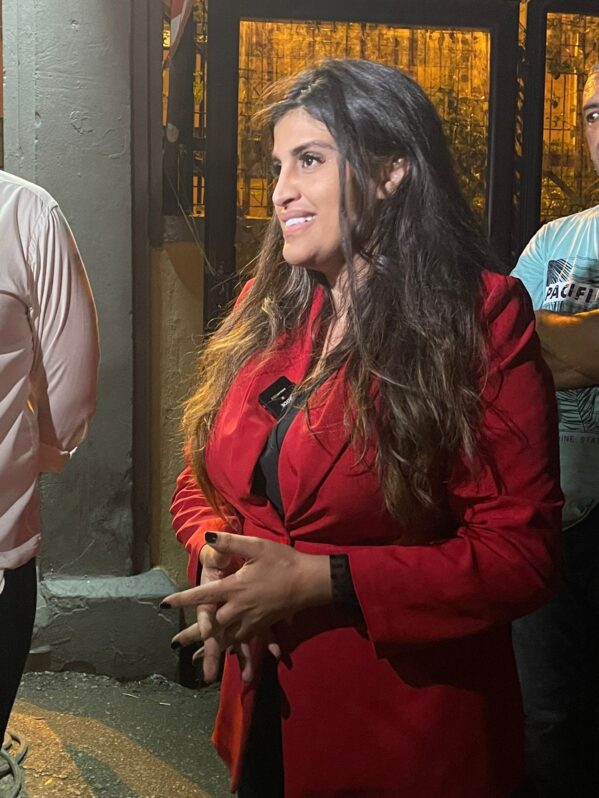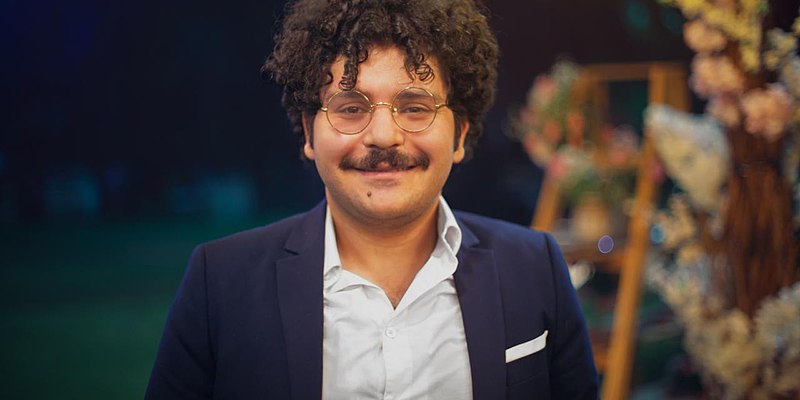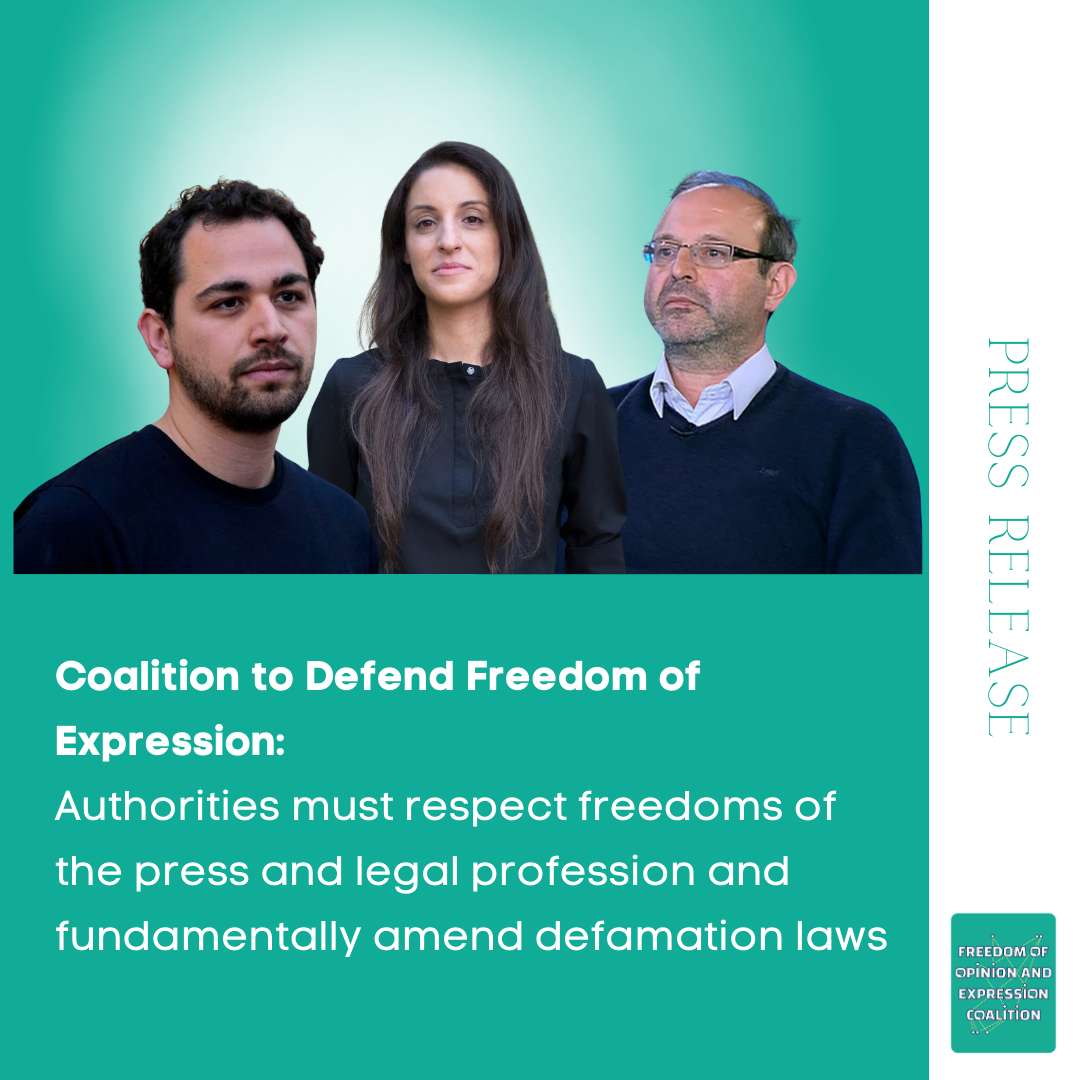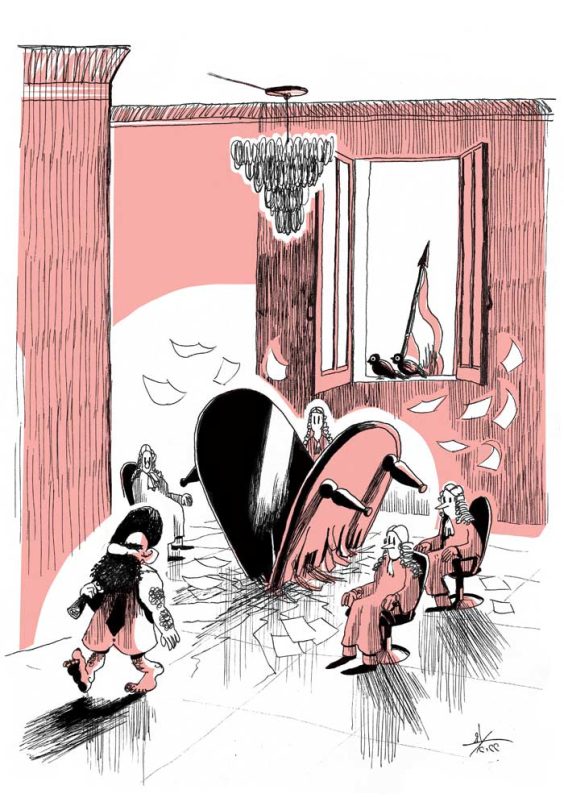Youth Conferences and Programs in Egypt: Spaces for Expression or Instruction?
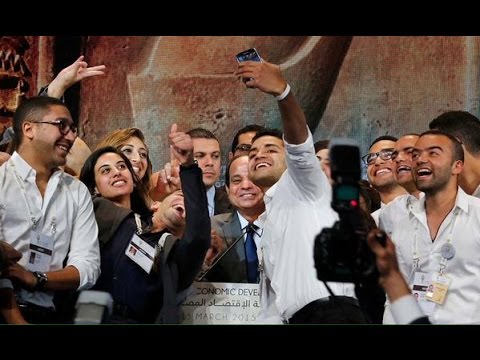
In the closing ceremony of the first Egypt Economic Development Conference in March 2015, President Abdel Fattah el-Sisi stood and delivered a speech. Before beginning, he invited youth who helped organize and coordinate the conference to the stage. A group of young men and women aged 18 to 25 ascended to the stage enthusiastically and spontaneously gathered around the president. One of them then took out his phone and captured a “selfie” with his fellow youth as they surrounded the president amid laughter from him and the audience of ministers, diplomats, and investors from Egypt and abroad.
While this ceremony occurred, over 1,000 male and female university students were in detention,[1] and the pro-regime media was vocally portraying the youth as a subversive, wayward group. Hence, this shot reveals the development of a new discourse and policy directed toward the Egyptian youth, one supported and adopted personally by the president in cooperation with state institutions from the military to various ministries. The first signs of this policy appeared in the speech Sisi delivered at Cairo University in September 2014, when he honored the “top university students”, as well as the students of the army and police faculties, and promised to include youth in decision-making by creating spaces for dialogue with them.[2] This promise was put into action via the inauguration of the so-called Youth Conferences, which have become one of the policies that the state follows periodically and systematically. The dialogue conferences for youth evolved from a national to global scale with the inauguration of the World Youth Forum in 2017. Alongside the spaces aimed at dialogue, specialized programs aiming to train cadres, the most important being the Presidential Leadership Program (the PLP), were also developed.
This article focuses on the two cornerstones of the state’s new policy toward youth in order to show that these policies do not create spaces for dialogue and expression for various cohorts of youth. They more so create spaces for disseminating the paradigm of youth that the state desires and strives to create while marginalizing any other paradigm, particularly the paradigm of the revolutionary youth. Similarly, the dialogue channels that these policies open are more like channels for directing youth toward the role expected of them and constitute a space for creating the state’s discourse toward youth. They are also being used as a space for decision-makers to comment on the new developments in the country, as occurred in the latest conference when Sisi responded to the corruption allegations directed at him by Mohamed Ali.
1- The Presidential Leadership Program: A New Channel for Creating Cadres?
The official PLP website defines the program as an initiative by the president and held directly under his auspices in partnership with several institutions[3] and aimed at training cadres who are skilled in leadership and business management and have all the necessary capacities to keep pace with the 21st century.[4] To that end, the program teaches economics, political science, security studies, and public administration in theory and practice.
The program brings together 500 male and female students chosen from all governorates based on an application process that includes a written exam followed by a face-to-face interview with the selection committee. The participants engage in lectures and various activities. The program’s practical component also involves holding periodic interviews with government officials, business owners, and media personnel. The program includes many practical training exercises in the form of simulations that put participants in real situations or situations inspired by reality for them to develop the policies and decisions they deem logical. The simulations in the PLP differ from the simulations found in many universities as the former focus more on domestic institutions than on regional and international ones. For example, in the 2017 conference in Ismailia, the “Egyptian State Simulation” was held. The simulations also occur in the presence or within sight of some of the people administering these institutions (such as ministers, officials, and the president himself).
After – or sometimes during – the program, the youth participate in many public events held by the state (e.g. they take part in organizing conferences or subsequent rounds of the program), and some are invited to take jobs in the centers of government decision-making. In the same vein, after several rounds of the program, the establishment of the National Training Academy for Youth was announced.[5] This academy was presented as being modeled after the National School of Administration in France (École nationale d'administration), and there was even talk about forming a partnership agreement with representatives from that school’s administration.[6]
Thus, the PLP is the first cornerstone of the state’s policies toward youth. The program is based on a discourse that mixes empowering youth with training future political leaders. In both aspects, a tone that combines neoliberalism and security is evident. The first appears in the attributes that the website introducing the program focuses on propagating in the participants, the most important and frequently repeated being entrepreneurship ability and a mentality and skills compatible with the market economy. For example, the English website states that the program aims to train youth to be “business minded” leaders and “entrepreneurs”.[7] Similarly, the focus on the practical and applicatory side of knowledge concords more with the idea of science’s economic benefit than with any other goal. As for the security-related tone, it appears in the primacy of the “war on terrorism” idea in the content of the simulations and the speeches that the youth present or hear.
Thus, we can consider the PLP a channel to recruit various cohorts of youth into the regime’s economic project with the promise of political empowerment. Although there are no clear statistics concerning the participants in the program, we can discern two categories of target youth.[8] The first comprises youth who have enjoyed a high standard of education in the special departments of government universities or even in the private universities and who already have proficiency in foreign languages, as well leadership and entrepreneurship abilities, including youth already involved in student activities in university or NGOs.[9] Hence, for such youth, joining the regime’s project is one channel among others for building a prosperous professional future, but the most important reason for participation remains social value and the possibility that they will have a voice in decision-making. As for the second category, it comprises youth from less fortunate social classes, who have the minimum linguistic and academic capacities to qualify them for participation. In this case, participating in such a program is a channel for upward mobility. Among such youth are those who already participated in the groups that the regime has tried to establish since coming to power in 2013, such as the Long Live Egypt party.
In reality, the PLP bears significant resemblance to the so-called Future Generation Foundation that Gamal Mubarak established when he was hoping to stand as a potential political candidate to succeed his father and to appear as the bearer of “new thought” and a new paradigm for state administration and decision-making. With the beginning of a second wave of privatization and hegemony of technocrats directing global corporations and working in international financial institutions over decision-making in Egypt, a need to build a youth cadre to be incorporated into this project arose.[10] The foundation activated the recruitment channels existing in the universities at the time, namely student unions, university fraternities, and leadership training camps.
There may be two fundamental differences between Gamal Mubarak’s project and the current project to train cadres. Firstly, Gamal Mubarak’s program did not include the level of youth participation from the upper middle classes evident in the PLP. Secondly, the paradigm of youth that the decision-makers in the current regime are promoting almost explicitly contradicts the paradigm of activist youth and youth involved in political movements and parties in the 2011-2013 period. This contradiction was not accounted for in Gamal Mubarak’s project. The following section investigates more extensively the manifestations of this contradiction that appears in the “dialogue” spaces, i.e. the Youth Conferences.
2- Conferences for Youth or for Addressing Youth?
After the president’s speech at Cairo University in September 2014, a series of periodic youth conferences began under the title “Innovate! Set forth!”. So far, eight conferences in governorates including Cairo, Alexandria, Aswan, and Ismailia have been convened, each involving approximately 1,000 young men and women.
The video introducing these conferences shows the president sitting surrounded by a group of ministers and officials from many fields and young men and women aged 18 to 25. The president listens attentively to the interventions by the youth, some presenting community-based initiatives, some participating in dialogue sessions or simulations. Some of these conferences also include segments titled “Ask the President”, in which the president welcomingly answers questions directed to him via social media.
These conferences are presented as “a space for dialogue with youth from all backgrounds” aiming to “remove the barriers between the state and the youth”. The introductory video focuses on underscoring that they are a space for free and safe discussion. Hence, a video shot show how a youth asks questions that seem critical of circumstances, and the president responds by inviting them to speak however they please without repercussions.
These conferences also aim to promote the image of the state and the decision-makers as caretakers of minorities and marginalized groups. For example, the conferences are held in various governorates of Upper Egypt and the Suez Canal region, not just the capital. Similarly, at the forefront appear youth with Coptic names and young women with varied appearances who assume responsibilities or take the floor in the conferences. The topic of disability also comes up repeatedly, and the president honors ideal examples of youth with disabilities.
In one of the national conferences, a call emerged (from the participants) for a global youth forum. The president adopted this call, and the first forum was held in November 2017 in Sharm el-Sheikh involving 3,000 youths from 166 states.[11] This forum, too, was presented as a space for dialogue between the decision-makers in Egypt and the world’s youth, as best evidenced by the promotional hashtag for the first convention: #WeNeedToTalk.
In both the national conferences and the global forums, several topics were addressed repeatedly, the most prominent being security, emigration, the war on terrorism, entrepreneurship, and leadership skills. Also addressed were global issues that the government wants to show are on the decision-makers’ agenda, such as women’s rights, migration, human trafficking, and digital security.
Because these conferences are directed at youth, social media is used extensively to promote them. They also appear as a topic of discussion and debate concerning their harm, benefits, and risks. Because social media is a relatively open space, in 2017 some bloggers opposed to the regime targeted the #WeNeedToTalk hashtag to shed light on the political detentions as well as cases of torture and forced disappearance.[12]
Despite the decision-makers’ great effort to appear as though they are trying to communicate with youth and to present these conferences and forums as a space of dialogue, expression, education, training, and interaction, the conferences are primarily a space that the state created to form a new, desirable paradigm of youth, as well as a space for officials, particularly the president, to deliver speeches and messages.
On one hand, the official song for the first World Youth Forum, titled “I Dream of a Place” (Bahlam bi-Makan), was performed by a group of young male and female artists from the countries participating in the conference. The video shows young men and women from multiple nationalities, each dressed in their country’s traditional attire, as the main tourist landmarks of their countries appear behind them against a clear sky and smiles appear on their faces. The lyrics focus on peace, well-being, harmony, achieving dreams, and rejecting hate and violence.
This song, along with the slogans of the national conferences and global forums, illustrate the scope of the acceptable role for youth[13] and the vision of the ideal youth. The most important characteristics of this paradigm are personal ambition that translates into material profit and the ability to innovate new ideas to recover from crises and implement them in the form of startups. This ideal youth is also distinguished by its placidity and rejection of violence and is certainly not agitable, subversive, or rebellious. This image is the antithesis of the idea of the revolutionary young man or woman (at least as envisaged by the decision-makers), i.e. rebelling against authority, rejecting things taken for granted, and risking personal safety for the sake of a higher cause.
On the other hand, the president figure takes center stage in these conferences, with the focus given to certain aspects of his public persona confirming the conferences’ purpose. In other words, in all the conferences we see the president listen and write notes in an attempt to show his openness, interest, and interaction with what the youth participating say. Then we see him occasionally joking around in an attempt to show humbleness and spontaneity. Finally, we see him representing activeness and vigor, taking the initiative to call for running and cycle races or even criticizing obesity and the decline in public health. This centrality doubtlessly makes the conferences a space for the president to deliver a popular discourse without making an official speech, a space for commenting on public affairs and delivering messages. This orientation became very clear recently in the Eighth National Youth Conference. The conference was hurriedly convened ahead of schedule, and the various seminars focused on the topics of combatting terrorism and the dangers of social media. The main goal of convening this conference, it seemed, was to give the president an opportunity in an unofficial setting to respond to the criticisms that had been directed at him on social media and provoked broad controversy.[14]
Conclusion
The state’s adoption of systematic policies to direct the youth is not in and of itself new. The current regime has followed the approach that its predecessors since the 1952 revolution followed and recruits youth via policies of creating the elite (such as the PLP) and of addressing the masses (such as the Youth Conferences).[15] However, what is new is that these conferences and programs are more than just channels for recruiting youth; they are spaces that the decision-makers created for directing and shaping the youth and marginalizing a particular paradigm of youth, from one angle, and for officials to express themselves and deliver comments outside the context of official discourse, from another angle.
This article is an edited translation from Arabic.
Keywords: Youth, Youth Conference, Egypt, Dialogue, Policies
[1] “Besieged Universities: on student rights in Egyptian public universities post 2013”, Association for Freedom of Thought and Expression (AFTE), 23 March 2017.
[2] Nadine Sika, “Youth Civic and Political Engagement in Egypt”, Power2Youth papers, September 2016.
[3] Originally, the website mentioned several ministries, such as the Ministry of Foreign Affairs, the Ministry of Defense, the Ministry of Planning, and the Ministry of Education. Currently, the only partners listed are the Ministry of Defense and the Ministry of Planning.
[4] See the official PLP website.
[5] Muhammad Hindawiyy, “al-Akadimiyya al-Wataniyya wa-Barnamij al-Ta’hil li-l-Qiyada.. Hulm al-Ra’is fi Dawla Yaquduha al-Shabab”, Akhbar el-Yom, 23 May 2019.
[6] “L'Académie égyptienne sera créée sur le modèle de l’ENA française”, 19 February 2018.
[8] This we determined by following the media’s coverage of the conferences and via unofficial interviews with participants in several student activities in Egyptian universities (2013-2017).
[9] Nadine Sika, “Youth Civic and Political Engagement in Egypt”, op. cit.
[10] Assia Boutaleb, “La Jeunesse En Tant Qu’objet et Enjeu de Légitimation En Egypte (2000-2004): Prodiges et Litiges de La Légitimité”, Ph.D. dissertation, Paris, Institut d'études politiques, 2006.
[11] See the Youth Conference’s website.
[12] “When Egypt’s World Youth Forum #WeNeedToTalk backfires”, BBC, 2 November 2017.
[13] Michele Dunne and Katie Bentivoglio, “Egypt’s Student Protests: The Beginning or the End of Youth Dissent?”, Carnegie, 22 October 2014.
[14] Nada Osman, “Anti-Sisi hashtag trends as Egypt’s president branded as kleptocrat”, Middle East Eye, 16 September, 2019.
[15] For more about youth policies from the 1950s to the beginning of the 21st century, see Assia Boutaleb, “La Jeunesse”, op. cit.
